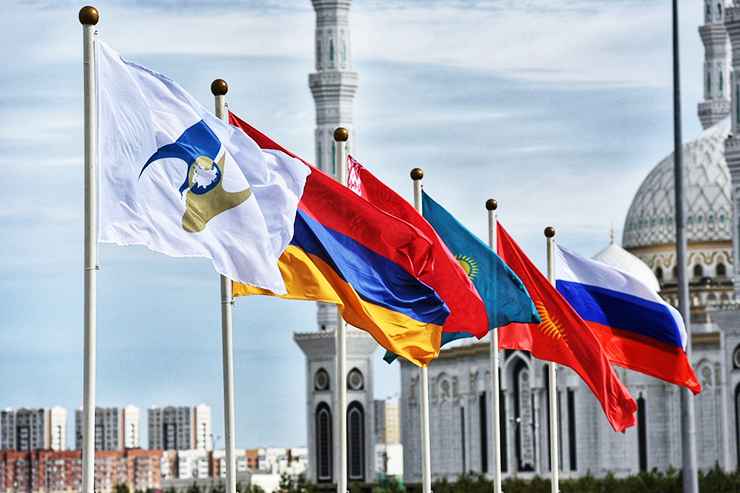The Russian Federation has stepped up its efforts to increase the influence of the EAEU in the countries catching the Kremlin’s geopolitical interest. In this case, the geo-economy is only a screen, and economic agreements are more likely to legalize associations in the world than bring significant benefits to the business of the EAEU member countries. There is even a decline in economic activity in the sector of mutual trade inside the organization.
The Balkans are the first direction of Russian activation in expanding the EAEU influence.On October 25, the FTZ agreement was signed with Serbia. It was signed amid complex negotiations and arrangements between Moscow and Belgrade. The economic benefits of the treaty for the EAEU member countries are scanty and estimated at around $ 16 million a year. Therefore, the treaty has a more propaganda and geopolitical purpose than an economic one. Thus, Russia is trying to return its traditional ally in the Balkans to its area of influence.
On October 30, Vladimir Chizhov, the Permanent Representative of the Russian Federation to the EU invited the leaders of Albania and North Macedonia to consider joining the EAEU. A negative response to this proposal has already come from North Macedonia. However, this does not mean that Russia will stop seeking to promote its interests in the region, focusing on the states once having been the part of the USSR’s sphere of influence.
The post-Soviet countries are the second direction of Russia’s activation in expanding the EAEU influence.
On October 2, Valentina Matviyenko, the Federation Council Speaker claimed that Uzbekistan’s President Shavkat Mirziyoyev had decided to consider joining the EAEU. The statement prompted an exchange of views between the US Secretary of Commerce Wilbur Ross and Russian Prime Minister Dmitry Medvedev. Ross said Uzbekistan’s accession to the EAEU could seriously complicate its accession to the WTO. Instead, Medvedev called such statements a method of non-competitive struggle.
In October, Azerbaijan’s possible entry into the EAEU or becoming its observer triggered a debate in the media. This topic was first raised during an interview with the Prime Minister of Armenia, Nicola Pashinyan, who declined to discuss the topic. Instead, Irek Zinnurov, Russian State Duma deputy, member of the State Duma Committee on the CIS, Eurasian Integration and Communications with Compatriots said that Russia wanted Azerbaijan to join the EAEU and Azerbaijan could become a full member of the organization.
Moldova’s President, Igor Dodon, demonstrates his active readiness to expand cooperation with the EAEU. Moldova received observer status on May 14, 2018.
Iran is the third direction of Russia’s activation in expanding the EAEU influence. On October 27, the Interim Free Trade Agreement between the organization and Iran entered into force. Despite the rather tangible list of goods included in the Agreement, this decision is rather geopolitical, since it is not practically applied to all EAEU members. The Kremlin is thus trying to cement the Moscow-Tehran geopolitical axis.
The countries of Africa are the fourth direction.On October 24, a Memorandum of Understanding was signed between the Eurasian Economic Commission and the African Union Commission. The document was signed within the framework of the Russia-Africa summit, i.e., it became an instrument for promoting exclusively the RF interests in the region. Negotiations on cooperation with Egypt in the framework of the EAEU are actively underway.
South and Southeast Asia – the fifth direction.On October 1, an agreement on the FTZ with Singapore was signed. At the same time, Russia and in parvo Kazakhstan will gain the main benefit, according to trade statistics. The rest of the EAEU member states are unlikely to take advantage of the FTZ. The Russian Federation has also been negotiating with India on cooperation within the EAEU and, since 2015, has had the FTZ with Vietnam in the region.
Relations between China and the EAEU have been less successful, although some progress has been made. Negotiations with Mongolia are ongoing.
Apparently, the list of countries where the cooperation with the EAEU is intensified largely (excluding Singapore) coincides with the allies, satellites and countries the USSR cooperated with. Thus, Russia’s activation in the geopolitical space using geo-economic tools is worth talking. In this case, thegoal is solely to expand the geopolitical influence, not to increase economic or trade capacity.
At the same time, the economic slowdown continues within the EAEUitself. As of today, the EAEU official parties emphasize there are 36 obstacles to mutual trade. Their numbers have declined recently but remain critical. At the same time, the main complaints about obstacles keep on coming from the representatives of Kazakhstan as well as Belarus.
Between January and August, the mutual trade turnover of the EAEU member states fell by 3%, with mainly Belarus (-2.6%), Kyrgyzstan (-5%) and Russia (-2.3%) fall-off. Only Belarus (+ 2%) and Armenia (+ 6%) have managed to increase the export within the framework of the EAEU during that period. At the same time, Russia alone has a positive trade balance in the amount of USD 13 billion 185 million. The other countries have a negative balance: Armenia (- $ 514 million), Belarus (- $ 4.7 billion), Kazakhstan (- $ 5.3 billion), Kyrgyzstan (- $ 925 million). It is possible to trace similar tendencies in the foreign trade of EAEU member countries with other countries of the world.
Against this background, the Kremlin continues to focus its efforts not on the inside but on the outside.On October 1, the Supreme Eurasian Council appointed Serhey Glazyev the new EEC Minister of the Russian Federation. He is responsible for the EAEU development and integration. Some Russian experts have pointed out Glazyev’s role has diminished with this appointment. But this may indicate an increase in this vector, which has begun to take on a new meaning for the Kremlin.
Further geopolitical expansion of the EAEU and efforts to expand the area of the RF influence using this geo-economic instrument should be expected. These actions will be activated in the countries that had close or friendly ties with the USSR and the former USSR republics. The EAEU will simultaneously acquire more and more features of the political union, alongside with strengthening its integration processes.




